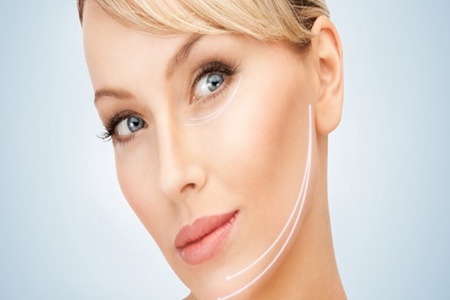
Non-Surgical Face Lift
What is Non-Surgical Face Lift (Triple V Lift)?
Triple V Lift is a stretching and lifting method by placing flat or spiny surgical threads with the help of a cannula. In this procedure, non-allergic PDO (polydioxanone) surgical threads are used to bring the areas which lost its elasticity back to their original positions. The threads placed under the skin melt away by the time, this triggers the wound healing feature of the texture, the result can be seen with the stimulation of the tissue made by the threads, tissue support and lifting created by the threads. Thus, both the skin structure is improved and elevation in the tissue is provided.
While PDO is loosening the muscles and tendons, it stimulates the mixture of new collagen, elastin and hyaluronic acid and thus it provides that the skin looks volume and juvenile.
In Which Areas Can Triple V Lift Be Applied?
Non-surgical ultra v lift process is applied to face, cheek and neck prolapse; chin, mouth, supraorbital lines and wrinkles; eyebrow lifting, forehead and wrinkles between eyebrows, cigarette lines above the lip, nose, cheek, lines between the interlabial lines and under eyes. Spider Web can also be used on the body in case of abdomen, arm prolapse.
What are the Benefits of Triple V Lift Application?
Triple V lift process without surgery is applied in the face area. In this area, it contributes to stretch the face, to lose the wrinkles, to lift the wrinkles and prolapse, to clarify the chin contours and facial contours by creating V lift effect, to have a clear, tight appearance around the cheekbone and eye.
What are The Periods and Stages of Triple V Lift Application?
While getting started application, to the area where the application is to be performed, the local anaesthetic cream is rubbed off and the area is narcotised. Threads with various features which will perform a duty of stretching and lifting in the areas that can be found suitable by the doctor, are placed with the help of the cannulas. After all the threads have been positioned in the necessary areas, all the threads are slowly and gradually pushed under the skin through the cannulas. After all the threads are positioned and placed, the spider web treatment is completed by applying soothing creams on the skin. Cold compress is applied for 15-20 minutes. It takes approximately 1-1.5 hours.
The surgical threads placed with the simple triple v lift procedure, can be removed by being absorbed by subcutaneous cells after a while. For this reason, these are not permanent for lifetime. How long the v lift effect lasts varies in each patient. Because every person’s skin structure, muscle structure, hormonal status and age are different. These criteria affect the permanence period. (Approximately 24-30 months)
Who Should Avoid From Triple V Lift Application?
Triple v lift process should not be applied to those who have a neuromuscular system disease (such as Eaton-Lambert syndrome, myasthenia gravis), in areas with active infection and inflammation, those who had facial paralysis within the last 1 year, those who are pregnant and breastfeeding.
What are the Points to Be Considered Before and After Triple V Lift Application?
Before the application, aspirin, blood thinners and alcohol should not be used. It’s recommended to come without makeup to the application. After the application, the person should not be exposed to the sunlight; high-factor sunscreen creams should be used. The treated area should not be exposed to water for 12 hours, processes such as massage, rub, peeling to the face should not be applied for 1 week, the person should not take a shower with hot water for 1 week. Alcohol should not be consumed on the application day. Lying position for the application day is recommended as an angle of 45 degrees.
What Are the Side Effects of Triple V Lift Application?
After the triple v lift application, the side effects that may occur are the dislocation of the thread, swelling, oedema, redness, bruising at the entrance of the needle and scar, headache, pain in the application area.
